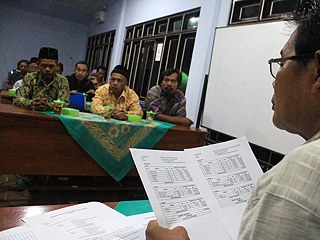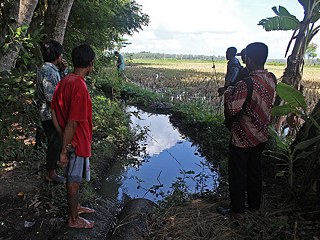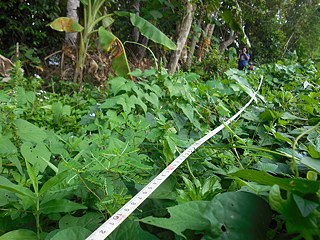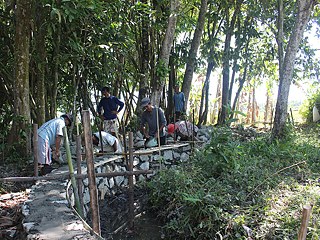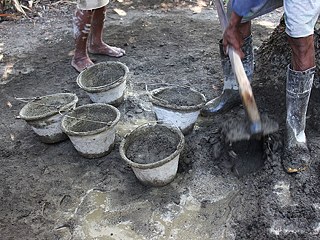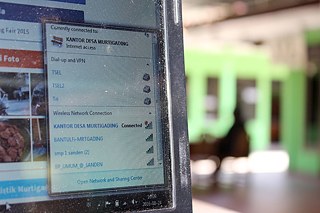Data2Life.Life2Data.
Budget transparency and villager participation in the construction of a tertiary dike in the village of Murtigading
Aris H, NisrinaCRI (Combine Resource Institute) – Infest (Institute of Education Development, Social, Religious and Cultural Studies)
The majority of villagers in Murtigading work as farmers or agricultural workers. According to the village administration there are 118 farmers and 799 agricultural workers dependent on the agricultural products. Because the fields need water, it is absolutely necessary to build a tertiary dike in the village of Murtigading.
Pucanganom 1 and Trisigan are two communities that do not yet have a dike. The construction of the dikes was initiated by villagers who made the proposal in a village meeting. Irrigation of the fields is not optimal without dikes, which enable the water to flow properly. A dike also benefits agricultural workers because they can more easily transport the harvest along the dike to their village. The construction of the dikes in the two communities is funded by the 2016 budget of the respective villages. Each community receives 20 million rupiah (a total of 40 million rupiah) to build the dikes.
Before the construction of the dikes began, the development team of Murtigading (TPK) informed the village head and residents about the upcoming project and the distribution of funds. Although a budget for the construction of the dikes was made available, it was not much. Agricultural workers who had no work after the harvest were employed to build the dikes. It was mainly eight agricultural workers and a few helpers in Puncanganom who built the dikes. A number of residents from Puncanganom also helped out in their free time. Because costs could be saved, it was possible to extend the originally planned 50-metre long dike to 120 metres.
COMBINE (Community-based Information Network) Resource Institution, an institution of the CRI
The Combine Resource Institution was founded on the basis that the revolution in information and communication technology is a sign of strength. The conviction that information is power has been confirmed more than ever in this digital age. Anyone who has information and uses it intelligently will be in a position of strength and power. A further effect of the development of information technology is the emergence of opportunities for disadvantaged groups in the population – they now have the opportunity to obtain information and strengthen their position. This includes agricultural workers, labourers, locals and the poor.
These groups can now access information that is important to them, are able to empower themselves, and can speak with the relevant parties – especially with government officials – about their needs. This is the basis of the COMBINE Resource Institution, whose strategy is to empower marginalised groups by means of information networks.
Infest stands for the Institute of Education Development, Social, Religious and Cultural Studies
Infest is a non-governmental institution working to increase the quality of life of the Indonesian people. Since March 2010 Infest Yogyakarta has implemented several projects that have been funded either by donations or with the help of government institutions. The activities reflect the aspirations of the institution to strengthen democracy, improve public service, and promote civil society. Infest’s vision is to accelerate the democratization process in Indonesia and to improve the standard of living of Indonesians.
The Combine Resource Institution was founded on the basis that the revolution in information and communication technology is a sign of strength. The conviction that information is power has been confirmed more than ever in this digital age. Anyone who has information and uses it intelligently will be in a position of strength and power. A further effect of the development of information technology is the emergence of opportunities for disadvantaged groups in the population – they now have the opportunity to obtain information and strengthen their position. This includes agricultural workers, labourers, locals and the poor.
These groups can now access information that is important to them, are able to empower themselves, and can speak with the relevant parties – especially with government officials – about their needs. This is the basis of the COMBINE Resource Institution, whose strategy is to empower marginalised groups by means of information networks.
Infest stands for the Institute of Education Development, Social, Religious and Cultural Studies
Infest is a non-governmental institution working to increase the quality of life of the Indonesian people. Since March 2010 Infest Yogyakarta has implemented several projects that have been funded either by donations or with the help of government institutions. The activities reflect the aspirations of the institution to strengthen democracy, improve public service, and promote civil society. Infest’s vision is to accelerate the democratization process in Indonesia and to improve the standard of living of Indonesians.
